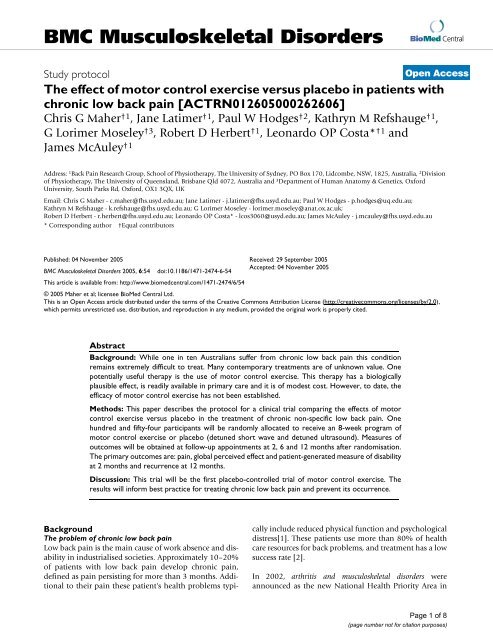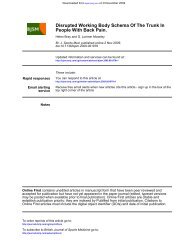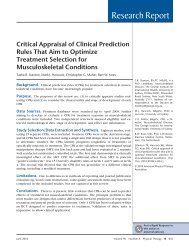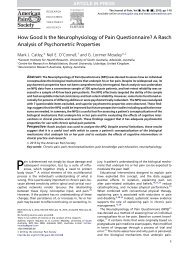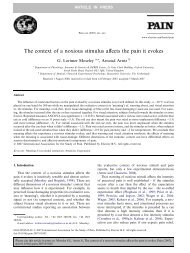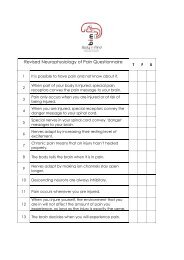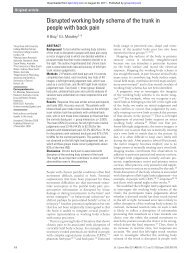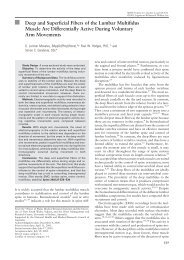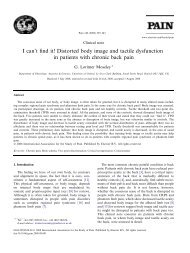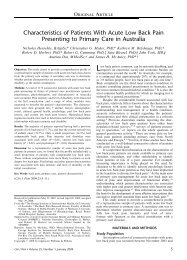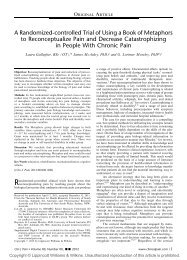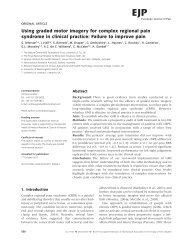The effect of motor control exercise versus placebo in patients with ...
The effect of motor control exercise versus placebo in patients with ...
The effect of motor control exercise versus placebo in patients with ...
Create successful ePaper yourself
Turn your PDF publications into a flip-book with our unique Google optimized e-Paper software.
BMC Musculoskeletal Disorders<br />
BioMed Central<br />
Study protocol<br />
<strong>The</strong> <strong>effect</strong> <strong>of</strong> <strong>motor</strong> <strong>control</strong> <strong>exercise</strong> <strong>versus</strong> <strong>placebo</strong> <strong>in</strong> <strong>patients</strong> <strong>with</strong><br />
chronic low back pa<strong>in</strong> [ACTRN012605000262606]<br />
Chris G Maher †1 , Jane Latimer †1 , Paul W Hodges †2 , Kathryn M Refshauge †1 ,<br />
G Lorimer Moseley †3 , Robert D Herbert †1 , Leonardo OP Costa* †1 and<br />
James McAuley †1<br />
Open Access<br />
Address: 1 Back Pa<strong>in</strong> Research Group, School <strong>of</strong> Physiotherapy, <strong>The</strong> University <strong>of</strong> Sydney, PO Box 170, Lidcombe, NSW, 1825, Australia, 2 Division<br />
<strong>of</strong> Physiotherapy, <strong>The</strong> University <strong>of</strong> Queensland, Brisbane Qld 4072, Australia and 3 Department <strong>of</strong> Human Anatomy & Genetics, Oxford<br />
University, South Parks Rd, Oxford, OX1 3QX, UK<br />
Email: Chris G Maher - c.maher@fhs.usyd.edu.au; Jane Latimer - j.latimer@fhs.usyd.edu.au; Paul W Hodges - p.hodges@uq.edu.au;<br />
Kathryn M Refshauge - k.refshauge@fhs.usyd.edu.au; G Lorimer Moseley - lorimer.moseley@anat.ox.ac.uk;<br />
Robert D Herbert - r.herbert@fhs.usyd.edu.au; Leonardo OP Costa* - lcos3060@usyd.edu.au; James McAuley - j.mcauley@fhs.usyd.edu.au<br />
* Correspond<strong>in</strong>g author †Equal contributors<br />
Published: 04 November 2005<br />
BMC Musculoskeletal Disorders 2005, 6:54 doi:10.1186/1471-2474-6-54<br />
This article is available from: http://www.biomedcentral.com/1471-2474/6/54<br />
Received: 29 September 2005<br />
Accepted: 04 November 2005<br />
© 2005 Maher et al; licensee BioMed Central Ltd.<br />
This is an Open Access article distributed under the terms <strong>of</strong> the Creative Commons Attribution License (http://creativecommons.org/licenses/by/2.0),<br />
which permits unrestricted use, distribution, and reproduction <strong>in</strong> any medium, provided the orig<strong>in</strong>al work is properly cited.<br />
Abstract<br />
Background: While one <strong>in</strong> ten Australians suffer from chronic low back pa<strong>in</strong> this condition<br />
rema<strong>in</strong>s extremely difficult to treat. Many contemporary treatments are <strong>of</strong> unknown value. One<br />
potentially useful therapy is the use <strong>of</strong> <strong>motor</strong> <strong>control</strong> <strong>exercise</strong>. This therapy has a biologically<br />
plausible <strong>effect</strong>, is readily available <strong>in</strong> primary care and it is <strong>of</strong> modest cost. However, to date, the<br />
efficacy <strong>of</strong> <strong>motor</strong> <strong>control</strong> <strong>exercise</strong> has not been established.<br />
Methods: This paper describes the protocol for a cl<strong>in</strong>ical trial compar<strong>in</strong>g the <strong>effect</strong>s <strong>of</strong> <strong>motor</strong><br />
<strong>control</strong> <strong>exercise</strong> <strong>versus</strong> <strong>placebo</strong> <strong>in</strong> the treatment <strong>of</strong> chronic non-specific low back pa<strong>in</strong>. One<br />
hundred and fifty-four participants will be randomly allocated to receive an 8-week program <strong>of</strong><br />
<strong>motor</strong> <strong>control</strong> <strong>exercise</strong> or <strong>placebo</strong> (detuned short wave and detuned ultrasound). Measures <strong>of</strong><br />
outcomes will be obta<strong>in</strong>ed at follow-up appo<strong>in</strong>tments at 2, 6 and 12 months after randomisation.<br />
<strong>The</strong> primary outcomes are: pa<strong>in</strong>, global perceived <strong>effect</strong> and patient-generated measure <strong>of</strong> disability<br />
at 2 months and recurrence at 12 months.<br />
Discussion: This trial will be the first <strong>placebo</strong>-<strong>control</strong>led trial <strong>of</strong> <strong>motor</strong> <strong>control</strong> <strong>exercise</strong>. <strong>The</strong><br />
results will <strong>in</strong>form best practice for treat<strong>in</strong>g chronic low back pa<strong>in</strong> and prevent its occurrence.<br />
Background<br />
<strong>The</strong> problem <strong>of</strong> chronic low back pa<strong>in</strong><br />
Low back pa<strong>in</strong> is the ma<strong>in</strong> cause <strong>of</strong> work absence and disability<br />
<strong>in</strong> <strong>in</strong>dustrialised societies. Approximately 10–20%<br />
<strong>of</strong> <strong>patients</strong> <strong>with</strong> low back pa<strong>in</strong> develop chronic pa<strong>in</strong>,<br />
def<strong>in</strong>ed as pa<strong>in</strong> persist<strong>in</strong>g for more than 3 months. Additional<br />
to their pa<strong>in</strong> these patient's health problems typically<br />
<strong>in</strong>clude reduced physical function and psychological<br />
distress[1]. <strong>The</strong>se <strong>patients</strong> use more than 80% <strong>of</strong> health<br />
care resources for back problems, and treatment has a low<br />
success rate [2].<br />
In 2002, arthritis and musculoskeletal disorders were<br />
announced as the new National Health Priority Area <strong>in</strong><br />
Page 1 <strong>of</strong> 8<br />
(page number not for citation purposes)
BMC Musculoskeletal Disorders 2005, 6:54<br />
http://www.biomedcentral.com/1471-2474/6/54<br />
recognition <strong>of</strong> the major health and economic burden<br />
that these diseases place on the Australian community [3].<br />
Amongst this group <strong>of</strong> diseases back pa<strong>in</strong> is both the most<br />
prevalent and most costly s<strong>in</strong>gle disease [4]. <strong>The</strong> 2001<br />
National Health Survey revealed that chronic back pa<strong>in</strong> is<br />
the most prevalent illness from the seven National Health<br />
Priority Areas [5].<br />
<strong>The</strong> severity <strong>of</strong> chronic pa<strong>in</strong> can be described <strong>with</strong> four<br />
hierarchical grades, Grades I–IV, that consider the pa<strong>in</strong><br />
<strong>in</strong>tensity and the degree <strong>of</strong> disability associated <strong>with</strong> the<br />
pa<strong>in</strong> [6]. An Australian population-based survey, noted<br />
that 22% <strong>of</strong> respondents reported chronic pa<strong>in</strong> <strong>with</strong> 39%<br />
<strong>of</strong> respondents classed as Grade I (least severe), 35% as<br />
Grade II, 14% as Grade III and 13% as Grade IV (most<br />
severe) [7]. <strong>The</strong> most common cause <strong>of</strong> chronic pa<strong>in</strong> was<br />
low back pa<strong>in</strong> (45% <strong>of</strong> cases).<br />
Effectiveness <strong>of</strong> treatments for chronic low back pa<strong>in</strong><br />
While there are a myriad <strong>of</strong> treatment options for chronic<br />
low back pa<strong>in</strong>, there is only one cl<strong>in</strong>ical practice guidel<strong>in</strong>e<br />
for chronic non-specific low back pa<strong>in</strong>: <strong>The</strong> European<br />
Guidel<strong>in</strong>e[8]. This guidel<strong>in</strong>e and the relevant Cochrane<br />
reviews [9] provide the most reliable sources <strong>of</strong> evidence<br />
on treatment for this condition. Unfortunately the<br />
Cochrane reviews provide fairly bleak read<strong>in</strong>g for both cl<strong>in</strong>icians<br />
and <strong>patients</strong>. Most <strong>of</strong> the reviews (7/13) concluded<br />
that the treatment under review was <strong>of</strong> unknown<br />
value. Five <strong>of</strong> the thirteen reviews concluded that there<br />
was some evidence for the treatment under review however<br />
significant limitations for each treatment were noted.<br />
<strong>The</strong>se limitations <strong>in</strong>cluded: no long term <strong>effect</strong> (e.g. back<br />
school); serious side <strong>effect</strong>s (e.g. muscle relaxants); small<br />
<strong>effect</strong> size (e.g. massage); treatment improves outcomes<br />
other than pa<strong>in</strong> (e.g. work condition<strong>in</strong>g) and no <strong>in</strong>formation<br />
available on patient or dose selection (e.g. behavioural<br />
treatment). <strong>The</strong> European Guidel<strong>in</strong>e produced<br />
similar conclusions [8]. In only one Cochrane review, the<br />
review <strong>of</strong> multidiscipl<strong>in</strong>ary rehabilitation/functional restoration,<br />
did the reviewers conclude that there was strong<br />
evidence for the therapy. However the reviewers also<br />
noted that these programs were only <strong>effect</strong>ive when they<br />
<strong>in</strong>cluded >100 hours <strong>of</strong> therapy. Because these programs<br />
are multidiscipl<strong>in</strong>ary they are typically provided <strong>in</strong> a tertiary<br />
sett<strong>in</strong>g and because <strong>of</strong> the amount <strong>of</strong> time <strong>in</strong>volved<br />
they are also very expensive. Accord<strong>in</strong>gly functional restoration<br />
is usually reserved for the most severe cases <strong>of</strong><br />
chronic low back pa<strong>in</strong>.<br />
<strong>The</strong> majority <strong>of</strong> <strong>patients</strong> <strong>with</strong> chronic low back pa<strong>in</strong> has<br />
less severe pa<strong>in</strong> (i.e. Grades I–III) and are typically managed<br />
<strong>in</strong> primary care. Not surpris<strong>in</strong>gly cl<strong>in</strong>icians f<strong>in</strong>d manag<strong>in</strong>g<br />
chronic low back pa<strong>in</strong> difficult <strong>with</strong> qualitative<br />
research report<strong>in</strong>g that therapists' <strong>in</strong>ability to identify<br />
<strong>effect</strong>ive treatment choices for their <strong>patients</strong> makes them<br />
state cl<strong>in</strong>icians perhaps feel 'helpless' 'disillusioned' and<br />
'pessimistic' [10]. Studies <strong>of</strong> <strong>patients</strong> reveal similar negative<br />
feel<strong>in</strong>gs and emotions [11].<br />
To address this major problem, we plan to beg<strong>in</strong> a coord<strong>in</strong>ated<br />
program <strong>of</strong> research <strong>in</strong> which treatments that seem<br />
most promis<strong>in</strong>g are rigorously evaluated <strong>in</strong> randomised<br />
<strong>control</strong>led trials. We def<strong>in</strong>e 'most promis<strong>in</strong>g treatments'<br />
as those that (i) appear to have cl<strong>in</strong>ically important <strong>effect</strong>s<br />
that are ma<strong>in</strong>ta<strong>in</strong>ed <strong>in</strong> the long term, (ii) are readily available<br />
and <strong>of</strong> modest cost and (iii) there is biological plausibility<br />
for the <strong>effect</strong>. Exercise therapy is our first candidate<br />
for evaluation <strong>in</strong> this program <strong>of</strong> research because it satisfies<br />
each <strong>of</strong> these three criteria, however at present trials<br />
have reported conflict<strong>in</strong>g results.<br />
While some trials <strong>of</strong> <strong>exercise</strong> therapy have reported large,<br />
durable and cl<strong>in</strong>ically important <strong>effect</strong>s <strong>of</strong> treatment<br />
[12,13] others have not [14]. <strong>The</strong> uncerta<strong>in</strong>ty is reflected<br />
<strong>in</strong> the conclusion <strong>of</strong> the Cochrane review <strong>of</strong> <strong>exercise</strong> therapy:<br />
'...there is conflict<strong>in</strong>g evidence on the <strong>effect</strong>iveness <strong>of</strong><br />
<strong>exercise</strong> therapy...' [15]<br />
Many factors are likely to have contributed to the <strong>in</strong>consistent<br />
results across trials. Importantly, <strong>in</strong>terpretation <strong>of</strong><br />
the results <strong>of</strong> <strong>exercise</strong> trials is difficult because most trials<br />
have been pragmatic trials, compar<strong>in</strong>g two active treatments<br />
delivered <strong>in</strong> rout<strong>in</strong>e practice (e.g. <strong>exercise</strong> vs. usual<br />
medical care [12]; <strong>exercise</strong> vs. physiotherapy [16]) <strong>The</strong>se<br />
comparisons cannot provide a clear estimate <strong>of</strong> the <strong>effect</strong>s<br />
<strong>of</strong> <strong>exercise</strong> treatment because most <strong>of</strong> the comparison<br />
treatments are also <strong>of</strong> unknown efficacy. Secondly, there<br />
has been <strong>in</strong>sufficient appreciation by researchers conduct<strong>in</strong>g<br />
trials and by reviewers summaris<strong>in</strong>g trials <strong>of</strong> the wide<br />
variety <strong>of</strong> forms <strong>exercise</strong> can take and also trials do not<br />
<strong>control</strong> the quality <strong>of</strong> <strong>exercise</strong> <strong>in</strong>tervention. While <strong>exercise</strong><br />
is typically regarded as a s<strong>in</strong>gle class <strong>of</strong> treatment we<br />
believe that this level <strong>of</strong> conception is <strong>in</strong>appropriate and<br />
analogous to not dist<strong>in</strong>guish<strong>in</strong>g between different classes<br />
and doses <strong>of</strong> drugs when prescrib<strong>in</strong>g medication. <strong>The</strong><br />
types <strong>of</strong> <strong>exercise</strong> programs for chronic low back pa<strong>in</strong> vary<br />
widely from land-based <strong>exercise</strong> <strong>versus</strong> <strong>exercise</strong> <strong>in</strong> water to<br />
isolated trunk <strong>exercise</strong> <strong>versus</strong> a walk<strong>in</strong>g program and it is<br />
unlikely that all programs are equally <strong>effect</strong>ive for all<br />
<strong>patients</strong>. Lastly, methodological quality varies greatly<br />
across previous <strong>exercise</strong> trials, for example <strong>in</strong> the<br />
Cochrane review [15] the least sound trial attended to<br />
none <strong>of</strong> the n<strong>in</strong>e methodological criteria while the best<br />
attended to seven <strong>of</strong> the n<strong>in</strong>e. Because methodological<br />
quality has been shown to affect the results <strong>of</strong> trials <strong>in</strong><br />
other areas <strong>of</strong> health care [17] it is likely that a lack <strong>of</strong> rigor<br />
has contributed to the <strong>in</strong>consistent results.<br />
It is not sensible to talk about evaluat<strong>in</strong>g the efficacy <strong>of</strong><br />
<strong>exercise</strong> <strong>with</strong>out specify<strong>in</strong>g the type <strong>of</strong> <strong>exercise</strong>. We have<br />
Page 2 <strong>of</strong> 8<br />
(page number not for citation purposes)
BMC Musculoskeletal Disorders 2005, 6:54<br />
http://www.biomedcentral.com/1471-2474/6/54<br />
chosen to measure the efficacy <strong>of</strong> <strong>motor</strong> <strong>control</strong> <strong>exercise</strong><br />
(sometimes called specific sp<strong>in</strong>al stabilisation <strong>exercise</strong>)<br />
for chronic low back pa<strong>in</strong>, rather than other forms <strong>of</strong> <strong>exercise</strong>,<br />
because it is a widely used form <strong>of</strong> <strong>exercise</strong> and there<br />
is an extensive body <strong>of</strong> literature that provides a rationale<br />
for the mechanism <strong>of</strong> action. <strong>The</strong> only way to clearly<br />
establish the value <strong>of</strong> <strong>motor</strong> <strong>control</strong> <strong>exercise</strong> <strong>in</strong> the management<br />
<strong>of</strong> chronic low back pa<strong>in</strong> is to evaluate the efficacy<br />
<strong>of</strong> this form <strong>of</strong> <strong>exercise</strong> therapy <strong>in</strong> a methodologically<br />
sound randomised <strong>placebo</strong>-<strong>control</strong>led trial. Prior to conduct<strong>in</strong>g<br />
a <strong>placebo</strong>-<strong>control</strong>led trial <strong>of</strong> <strong>exercise</strong> we felt that it<br />
was prudent to identify the most promis<strong>in</strong>g form <strong>of</strong> <strong>exercise</strong><br />
that would subsequently be evaluated <strong>in</strong> the <strong>placebo</strong><strong>control</strong>led<br />
trial. To do this we conducted a randomised<br />
<strong>control</strong>led trial where 160 <strong>patients</strong> were randomised to an<br />
8 week program <strong>of</strong> either <strong>motor</strong> <strong>control</strong> <strong>exercise</strong> or general<br />
<strong>exercise</strong>[18].<br />
<strong>The</strong> trial demonstrated that both programs were accompanied<br />
by large improvements <strong>in</strong> pa<strong>in</strong> and disability. Motor<br />
<strong>control</strong> <strong>exercise</strong> produced significantly better outcomes <strong>in</strong><br />
the short term, and there was a trend for <strong>motor</strong> <strong>control</strong><br />
<strong>exercise</strong> to produce better outcomes at 6 month followup.<br />
Accord<strong>in</strong>gly we have chosen to evaluate <strong>motor</strong> <strong>control</strong><br />
<strong>exercise</strong> <strong>in</strong> the proposed trial. Our choice co<strong>in</strong>cides <strong>with</strong><br />
the research agenda set by the 2004 European Guidel<strong>in</strong>e:<br />
"<strong>The</strong> <strong>effect</strong>iveness <strong>of</strong> specific types <strong>of</strong> <strong>exercise</strong> therapy<br />
needs to be further evaluated. This <strong>in</strong>cludes the evaluation<br />
<strong>of</strong> sp<strong>in</strong>al stabilisation <strong>exercise</strong>s..." [8] p 7.<br />
Motor <strong>control</strong> <strong>exercise</strong>: treatment rationale<br />
<strong>The</strong> use <strong>of</strong> <strong>motor</strong> <strong>control</strong> <strong>exercise</strong> is based on research that<br />
has shown that:<br />
(i) People <strong>with</strong> low back pa<strong>in</strong> have changes <strong>in</strong> the strategy<br />
for <strong>control</strong> <strong>of</strong> the trunk muscles <strong>in</strong> that activity <strong>of</strong> the deep<br />
muscles is impaired (delayed, less tonic) and these muscles<br />
are atrophied[19,20].<br />
(ii) Although all muscles contribute to <strong>control</strong> <strong>of</strong> movement<br />
and stability <strong>of</strong> the sp<strong>in</strong>e, the deep muscles have a<br />
critical role for <strong>control</strong> <strong>of</strong> <strong>in</strong>tervertebral motion [21-25],<br />
but <strong>with</strong> the potential advantage <strong>of</strong> allow<strong>in</strong>g dynamic<br />
<strong>control</strong> <strong>of</strong> the sp<strong>in</strong>e.<br />
(iii) Evidence that people <strong>with</strong> back pa<strong>in</strong> tend to adopt a<br />
strategy for <strong>in</strong>creased stiffness and stability at the expense<br />
<strong>of</strong> sp<strong>in</strong>al function [26].<br />
(iv) Non-resolution <strong>of</strong> changes <strong>in</strong> the deep muscle system<br />
is l<strong>in</strong>ked to recurrences <strong>of</strong> low back pa<strong>in</strong> [27].<br />
<strong>The</strong> evidence above underp<strong>in</strong>s the primary aim <strong>of</strong> <strong>motor</strong><br />
<strong>control</strong> <strong>exercise</strong>, which is to re-establish normal <strong>control</strong> <strong>of</strong><br />
the deep sp<strong>in</strong>al muscles, reduc<strong>in</strong>g the activity <strong>of</strong> more<br />
superficial muscles that tend to stiffen the sp<strong>in</strong>e and have<br />
<strong>in</strong>creased activity <strong>in</strong> low back pa<strong>in</strong>, and then ma<strong>in</strong>ta<strong>in</strong><br />
normal <strong>control</strong> dur<strong>in</strong>g progressively more demand<strong>in</strong>g<br />
physical and functional tasks[28].<br />
<strong>The</strong> key feature <strong>of</strong> the <strong>motor</strong> <strong>control</strong> <strong>exercise</strong> approach is<br />
the tra<strong>in</strong><strong>in</strong>g <strong>of</strong> the deep trunk muscles <strong>in</strong> isolation before<br />
progress<strong>in</strong>g to demand<strong>in</strong>g tasks that tra<strong>in</strong> coord<strong>in</strong>ation <strong>of</strong><br />
the deep and the superficial trunk muscles [28]. However,<br />
unlike functional restoration approaches, tra<strong>in</strong><strong>in</strong>g the<br />
deep trunk muscles <strong>in</strong> isolation from the superficial trunk<br />
muscles is difficult. In order to teach <strong>patients</strong> how to contract<br />
the deep muscles <strong>of</strong> the sp<strong>in</strong>e, <strong>in</strong> addition to cl<strong>in</strong>ical<br />
skills <strong>of</strong> palpation and observation [29] physiotherapists<br />
need to use technical devices such as pressure monitors,<br />
electromyography and ultrasound imag<strong>in</strong>g to provide<br />
feedback to the patient.<br />
<strong>The</strong> premise <strong>of</strong> the <strong>motor</strong> <strong>control</strong> approach is that simple<br />
functional <strong>exercise</strong> alone does not re-establish coord<strong>in</strong>ation<br />
<strong>of</strong> the trunk muscles. This premise is supported by<br />
the f<strong>in</strong>d<strong>in</strong>g that the adaptation <strong>of</strong> these muscles to pa<strong>in</strong> is<br />
still present follow<strong>in</strong>g recovery from an episode <strong>of</strong> low<br />
back pa<strong>in</strong>, when <strong>patients</strong> have returned to normal functional<br />
levels [19,20]. Furthermore, recent data confirm<br />
that coord<strong>in</strong>ation <strong>of</strong> the abdom<strong>in</strong>al muscles can be<br />
restored <strong>with</strong> tra<strong>in</strong><strong>in</strong>g <strong>of</strong> specific activation <strong>of</strong> the trunk<br />
muscles, but not a simple activation dur<strong>in</strong>g a sit up task<br />
[30]. Notably, non-resolution <strong>of</strong> muscle dysfunction is<br />
associated <strong>with</strong> <strong>in</strong>creased back pa<strong>in</strong> recurrence [27]. Also,<br />
asymptomatic people <strong>with</strong> normal activity levels who are<br />
unable to perform a task that is thought to reflect voluntary<br />
activation <strong>of</strong> the deep trunk muscles, are ~6 times<br />
more likely to develop back pa<strong>in</strong> than asymptomatic people<br />
who are able to perform the same task [31].<br />
Motor <strong>control</strong> <strong>exercise</strong>: level I and II evidence<br />
At present there is no evidence for the efficacy <strong>of</strong> <strong>motor</strong><br />
<strong>control</strong> <strong>exercise</strong> <strong>in</strong> the treatment <strong>of</strong> chronic low back pa<strong>in</strong>.<br />
No systematic review <strong>of</strong> <strong>motor</strong> <strong>control</strong> <strong>exercise</strong> has been<br />
published, although one is be<strong>in</strong>g completed by our group.<br />
While the majority <strong>of</strong> trials (5 <strong>of</strong> 8) report that <strong>motor</strong> <strong>control</strong><br />
<strong>exercise</strong> is <strong>effect</strong>ive <strong>in</strong> the management <strong>of</strong> chronic or<br />
recurrent low back pa<strong>in</strong> most (7 <strong>of</strong> 8) have permitted co<strong>in</strong>tervention<br />
so that the contribution <strong>of</strong> <strong>motor</strong> <strong>control</strong><br />
<strong>exercise</strong> is unclear. Additionally, all <strong>of</strong> these previous trials<br />
have used other treatments <strong>of</strong> unknown efficacy as the<br />
comparison <strong>in</strong>tervention and so treatment efficacy cannot<br />
be measured. For example the earliest trial [12] reported<br />
that <strong>motor</strong> <strong>control</strong> <strong>exercise</strong> is more <strong>effect</strong>ive than usual<br />
medical care however this result provides an ambiguous<br />
estimate <strong>of</strong> treatment <strong>effect</strong>iveness because other trials<br />
have reported that sham physiotherapy treatments are<br />
more <strong>effect</strong>ive than usual medical care [32].<br />
Page 3 <strong>of</strong> 8<br />
(page number not for citation purposes)
BMC Musculoskeletal Disorders 2005, 6:54<br />
http://www.biomedcentral.com/1471-2474/6/54<br />
We will evaluate the efficacy <strong>of</strong> <strong>motor</strong> <strong>control</strong> <strong>exercise</strong> <strong>in</strong><br />
a <strong>placebo</strong>-<strong>control</strong>led randomised <strong>control</strong>led trial. <strong>The</strong><br />
results <strong>of</strong> our study will be <strong>in</strong>valuable for more efficacious<br />
evidence-based management <strong>of</strong> <strong>patients</strong> <strong>with</strong> non-specific<br />
chronic low back pa<strong>in</strong>. Once efficacy is established, we<br />
will be able to progress to measur<strong>in</strong>g whether there are<br />
additive or multiplicative <strong>effect</strong>s <strong>of</strong> other treatments that<br />
are commonly adm<strong>in</strong>istered as co-<strong>in</strong>terventions <strong>with</strong><br />
<strong>motor</strong> <strong>control</strong> <strong>exercise</strong> and thus to be<strong>in</strong>g able to make<br />
valid recommendations for their use.<br />
Methods<br />
Overview <strong>of</strong> research design<br />
<strong>The</strong> study will be a randomised, bl<strong>in</strong>ded, <strong>placebo</strong>-<strong>control</strong>led<br />
trial <strong>of</strong> a <strong>motor</strong> <strong>control</strong> <strong>exercise</strong> program for <strong>patients</strong><br />
<strong>with</strong> chronic low back pa<strong>in</strong>. <strong>The</strong> <strong>exercise</strong> program will<br />
consist <strong>of</strong> 12 <strong>in</strong>dividually supervised half-hour sessions<br />
over an 8-week period <strong>with</strong> treatment outcomes measured<br />
at 2 months, 6 months and one year.<br />
Hypotheses<br />
(i) An 8-week <strong>motor</strong> <strong>control</strong> <strong>exercise</strong> program designed to<br />
restore <strong>control</strong> <strong>of</strong> the trunk muscles improves pa<strong>in</strong>, disability<br />
and global perceived <strong>effect</strong> <strong>in</strong> participants <strong>with</strong><br />
chronic low back pa<strong>in</strong> at 2 months follow-up.<br />
(ii) <strong>The</strong> improvements <strong>in</strong> pa<strong>in</strong>, disability and global perceived<br />
<strong>effect</strong> follow<strong>in</strong>g <strong>motor</strong> <strong>control</strong> <strong>exercise</strong> are ma<strong>in</strong>ta<strong>in</strong>ed<br />
at 6 and 12 months follow-up.<br />
(iii) At 12 month follow up recurrence is less <strong>in</strong> the <strong>motor</strong><br />
<strong>control</strong> <strong>exercise</strong> group.<br />
Subject recruitment<br />
A total <strong>of</strong> 154 participants will be recruited <strong>in</strong>to the study.<br />
Participants will be screened for suitability for <strong>motor</strong> <strong>control</strong><br />
<strong>exercise</strong> accord<strong>in</strong>g to usual cl<strong>in</strong>ical practice. <strong>The</strong><br />
screen<strong>in</strong>g <strong>in</strong>struments identify participants who are<br />
unsuitable for <strong>exercise</strong> management <strong>of</strong> their low back<br />
pa<strong>in</strong> because <strong>of</strong> significant co- morbidity (serious sp<strong>in</strong>al<br />
pathology, contra<strong>in</strong>dication to <strong>exercise</strong>). A cl<strong>in</strong>ical assessment<br />
will identify <strong>patients</strong> who we expect would best be<br />
managed by a <strong>motor</strong> <strong>control</strong> <strong>exercise</strong> program rather than<br />
some other form <strong>of</strong> <strong>exercise</strong> or physiotherapy management.<br />
Screen<strong>in</strong>g<br />
To screen for serious pathology, the physiotherapist will<br />
conduct a diagnostic triage [33]. Participants <strong>in</strong> whom<br />
serious sp<strong>in</strong>al pathology is suspected will be excluded<br />
from the trial and referred to their medical practitioner for<br />
review. Potential participants will be screened for contra<strong>in</strong>dications<br />
to <strong>exercise</strong> us<strong>in</strong>g the Physical Activity Read<strong>in</strong>ess<br />
Questionnaire [34]. If a volunteer provides a<br />
positive response to items 1, 2, 3, 4, 6 or 7, the trial physiotherapist<br />
will discuss the case <strong>with</strong> the referr<strong>in</strong>g medical<br />
practitioner and if necessary a medical review will be<br />
undertaken to exclude any contra<strong>in</strong>dication to <strong>exercise</strong> as<br />
listed <strong>in</strong> the ACSM guidel<strong>in</strong>es [34].<br />
<strong>The</strong> cl<strong>in</strong>ical assessment used to ensure that the <strong>motor</strong> <strong>control</strong><br />
approach is <strong>in</strong>dicated is based on the key text [28] and<br />
is a normal part <strong>of</strong> cl<strong>in</strong>ical assessment <strong>of</strong> low back pa<strong>in</strong>.<br />
<strong>The</strong> assessment <strong>in</strong>volves evaluation <strong>of</strong> the <strong>motor</strong> <strong>control</strong><br />
strategy dur<strong>in</strong>g a specific trunk muscle task – draw<strong>in</strong>g <strong>in</strong><br />
<strong>of</strong> the lower abdomen while ma<strong>in</strong>ta<strong>in</strong><strong>in</strong>g an isometric<br />
contraction <strong>of</strong> the medial back muscles. <strong>The</strong> follow<strong>in</strong>g criteria<br />
constitute correct performance <strong>of</strong> the task:<br />
1. Moderate and susta<strong>in</strong>ed activation (> 10 seconds) <strong>of</strong><br />
trans<strong>versus</strong> abdom<strong>in</strong>is<br />
2. Moderate and susta<strong>in</strong>ed activation (> 10 seconds) <strong>of</strong><br />
the lumbar multifidus muscles<br />
3. Little or no activation <strong>of</strong> the global trunk muscles<br />
4. No sp<strong>in</strong>al or rib cage movement.<br />
5. Normal breath<strong>in</strong>g<br />
Evaluation <strong>of</strong> task performance <strong>in</strong>clud<strong>in</strong>g satisfaction <strong>of</strong><br />
the above criteria is dependent on the cl<strong>in</strong>ical skills <strong>of</strong> the<br />
physiotherapist. Patients who are unable to perform this<br />
task correctly will be considered suitable for <strong>motor</strong> <strong>control</strong><br />
<strong>exercise</strong>.<br />
Participants will be <strong>in</strong>cluded if they meet all <strong>of</strong> the follow<strong>in</strong>g<br />
<strong>in</strong>clusion criteria:<br />
• Non-specific low back pa<strong>in</strong> +/- leg pa<strong>in</strong> <strong>of</strong> at least 3<br />
months duration<br />
• Currently seek<strong>in</strong>g care for low back pa<strong>in</strong><br />
• Aged greater than 18 and less than 80 years<br />
• Comprehends English<br />
• Cl<strong>in</strong>ical assessment <strong>in</strong>dicates that the subject is suitable<br />
for <strong>motor</strong> <strong>control</strong> <strong>exercise</strong><br />
• Expects to cont<strong>in</strong>ue resid<strong>in</strong>g <strong>in</strong> SWSAH region for study<br />
duration.<br />
Participants will be excluded if they have any <strong>of</strong> the follow<strong>in</strong>g:<br />
• Suspected or confirmed serious sp<strong>in</strong>al pathology (fracture,<br />
metastatic, <strong>in</strong>flammatory or <strong>in</strong>fective diseases <strong>of</strong> the<br />
Page 4 <strong>of</strong> 8<br />
(page number not for citation purposes)
BMC Musculoskeletal Disorders 2005, 6:54<br />
http://www.biomedcentral.com/1471-2474/6/54<br />
sp<strong>in</strong>e, cauda equ<strong>in</strong>a syndrome/widespread neurological<br />
disorder)<br />
• Suspected or confirmed pregnancy<br />
• Unable to speak English<br />
• Nerve root compromise (2 <strong>of</strong> strength, reflex or sensation<br />
affected for same nerve root)<br />
• Sp<strong>in</strong>al surgery<br />
• Scheduled for major surgery dur<strong>in</strong>g treatment or followup<br />
period<br />
• Any <strong>of</strong> the contra<strong>in</strong>dications to <strong>exercise</strong> listed on page<br />
42 <strong>of</strong> the ACSM guidel<strong>in</strong>es [34]<br />
• Any contra<strong>in</strong>dication to pulsed ultrasound or pulsed<br />
shortwave.<br />
Specific sp<strong>in</strong>al pathology or contra<strong>in</strong>dication to treatment<br />
may be suspected based on the results <strong>of</strong> the screen<strong>in</strong>g<br />
questionnaire and the Physical Activity Read<strong>in</strong>ess Questionnaire.<br />
If the assessor suspects the presence <strong>of</strong> any<br />
pathology or contra<strong>in</strong>dication to treatment, these subjects<br />
should be further <strong>in</strong>vestigated and medical clearance<br />
obta<strong>in</strong>ed, if necessary.<br />
Assessment and allocation<br />
Outcome measures<br />
Measures <strong>of</strong> outcomes will be obta<strong>in</strong>ed at follow-up<br />
appo<strong>in</strong>tments at 2, 6 and 12 months after randomisation.<br />
To maximise attendance at these follow-ups, appo<strong>in</strong>tments<br />
will be made by phone and then a letter will be sent<br />
confirm<strong>in</strong>g appo<strong>in</strong>tment and a rem<strong>in</strong>der phone call will<br />
be made 24 hrs before the appo<strong>in</strong>tment. Every attempt<br />
(<strong>with</strong><strong>in</strong> ethical constra<strong>in</strong>ts) will be made to obta<strong>in</strong> outcome<br />
data, regardless <strong>of</strong> subject's compliance <strong>with</strong> trial<br />
protocols. Follow-up measures will be scored by an <strong>in</strong>vestigator<br />
who is bl<strong>in</strong>ded to group allocation. At 2 months,<br />
<strong>in</strong>formation about side <strong>effect</strong>s <strong>of</strong> treatment will be collected<br />
from all participants us<strong>in</strong>g open-ended question<strong>in</strong>g.<br />
Follow<strong>in</strong>g the screen<strong>in</strong>g consultation, personal characteristics<br />
(age, gender, ethnicity, religion, weight, height, level<br />
<strong>of</strong> education, employment status, doctor's details and<br />
contact <strong>in</strong>formation) and <strong>in</strong>formation about symptoms<br />
<strong>of</strong> low back pa<strong>in</strong> will be collected (eg DASS 21 [35];<br />
Chronic Pa<strong>in</strong> Grade Questionnaire) <strong>The</strong> follow<strong>in</strong>g treatment<br />
efficacy variables will be measured at basel<strong>in</strong>e, 2, 6<br />
and 12 months.<br />
1. Average pa<strong>in</strong> <strong>in</strong>tensity over last week (0–10 scale) [36-<br />
38]<br />
2. Patient-generated measure <strong>of</strong> disability (Patient-Specific<br />
Functional Scale) [36-38]<br />
3. Global perceived <strong>effect</strong> (Global Perceived Effect Scale)<br />
[36-38]<br />
4. Condition-specific measure <strong>of</strong> disability (Roland Morris<br />
Disability Questionnaire) [36-38]<br />
5. Recurrence at 12 months<br />
<strong>The</strong> primary outcomes are pa<strong>in</strong>, GPE and PSFS at 2<br />
months and recurrence at 12 months.<br />
Randomisation<br />
Participants will be allocated to treatment group us<strong>in</strong>g<br />
sealed opaque envelopes. <strong>The</strong> allocation sequence will be<br />
generated by author CM. Participants will be scheduled to<br />
receive their first treatment <strong>with</strong><strong>in</strong> one week <strong>of</strong> randomisation.<br />
Interventions<br />
Contemporary physiotherapy practice <strong>in</strong> <strong>exercise</strong> prescription<br />
is to assess each patient and to implement the form<br />
<strong>of</strong> <strong>exercise</strong> that is most relevant to the particular cl<strong>in</strong>ical<br />
presentation. At present this widely accepted approach<br />
relies primarily upon the cl<strong>in</strong>ical expertise <strong>of</strong> the therapist.<br />
We have elected to evaluate <strong>motor</strong> <strong>control</strong> <strong>exercise</strong> delivered<br />
<strong>in</strong> this manner because this approach is regarded as<br />
contemporary best practice.<br />
Participants <strong>in</strong> each group will receive 12 half hour treatments<br />
over an 8-week period, i.e. 2 sessions/week <strong>in</strong> the<br />
first month and 1 session/week <strong>in</strong> the second month. <strong>The</strong><br />
treatment sessions are designed to become less frequent<br />
over time to encourage <strong>in</strong>dependence and cont<strong>in</strong>uation <strong>of</strong><br />
<strong>exercise</strong> when therapy is complete. This is consistent <strong>with</strong><br />
current cl<strong>in</strong>ical practice.<br />
<strong>The</strong> <strong>motor</strong> <strong>control</strong> <strong>exercise</strong> program is based on the treatment<br />
approach reported by O'Sullivan et al [12], Richardson<br />
et al [28], and Moseley [39]. A brief description is<br />
provided below.<br />
At the first session, participants will be comprehensively<br />
assessed and then will be prescribed <strong>exercise</strong>s aimed at<br />
improv<strong>in</strong>g function <strong>of</strong> specific muscles <strong>of</strong> the low back<br />
region to be conducted <strong>in</strong> sessions 2–11. Stage 1 <strong>in</strong>volves<br />
the most commonly prescribed <strong>exercise</strong> aimed at retra<strong>in</strong><strong>in</strong>g<br />
multifidus (a back muscle) and trans<strong>versus</strong> abdom<strong>in</strong>us<br />
(a deep abdom<strong>in</strong>al muscle); these <strong>exercise</strong>s will be<br />
supplemented <strong>with</strong> <strong>exercise</strong>s for the pelvic floor muscles,<br />
Page 5 <strong>of</strong> 8<br />
(page number not for citation purposes)
BMC Musculoskeletal Disorders 2005, 6:54<br />
http://www.biomedcentral.com/1471-2474/6/54<br />
breath<strong>in</strong>g <strong>control</strong> and <strong>control</strong> <strong>of</strong> sp<strong>in</strong>al posture. Participants<br />
will be taught how to contract these muscles <strong>in</strong>dependently<br />
from the superficial trunk muscles [28,40].<br />
Physiotherapists will use real-time ultrasound bi<strong>of</strong>eedback<br />
to enhance learn<strong>in</strong>g <strong>of</strong> the tasks. When participants<br />
are able to perform these <strong>exercise</strong>s, they will be gradually<br />
upgraded until the patient is able to ma<strong>in</strong>ta<strong>in</strong> isolated<br />
contractions <strong>of</strong> these muscles for 10 seconds, up to a maximum<br />
<strong>of</strong> 10 repetitions, dur<strong>in</strong>g normal respiration [28].<br />
When this level <strong>of</strong> competence has been achieved,<br />
<strong>patients</strong> will be considered ready to progress to Stage 2.<br />
Stage 2 <strong>of</strong> the approach <strong>in</strong>volves <strong>in</strong>creas<strong>in</strong>g the complexity<br />
<strong>of</strong> the <strong>exercise</strong> by progress<strong>in</strong>g through a range <strong>of</strong> functional<br />
tasks and <strong>exercise</strong>s target<strong>in</strong>g coord<strong>in</strong>ation <strong>of</strong> trunk<br />
and limb movement and ma<strong>in</strong>tenance <strong>of</strong> trunk stability.<br />
<strong>The</strong> range and progression <strong>of</strong> <strong>exercise</strong>s is well set-out <strong>in</strong><br />
cl<strong>in</strong>ical texts [28] and is <strong>in</strong>dividualised to the patient<br />
based on this presentation. Participants require the ongo<strong>in</strong>g<br />
support <strong>of</strong> a tra<strong>in</strong>ed physiotherapist to ensure correct<br />
performance <strong>of</strong> the <strong>exercise</strong>s. Session 12 is a discharge session<br />
where the patient's progress will be reviewed and<br />
<strong>patients</strong> will be prescribed <strong>exercise</strong>s to cont<strong>in</strong>ue at home.<br />
<strong>The</strong> <strong>placebo</strong> <strong>in</strong>tervention is 20 m<strong>in</strong>utes <strong>of</strong> detuned short<br />
wave diathermy and 5 m<strong>in</strong>utes <strong>of</strong> detuned ultrasound for<br />
12 sessions over an eight week period. This attention <strong>control</strong><br />
will be used because there is no known treatment<br />
<strong>effect</strong> from the detuned mach<strong>in</strong>es, but it has been established<br />
<strong>in</strong> previous trials (<strong>in</strong>clud<strong>in</strong>g one <strong>of</strong> our own [37])<br />
that participants view this as a credible treatment. To<br />
<strong>in</strong>crease the perceived credibility <strong>of</strong> the attention <strong>control</strong>,<br />
participants will undergo an exam<strong>in</strong>ation <strong>in</strong>clud<strong>in</strong>g rout<strong>in</strong>e<br />
screen<strong>in</strong>g for contra<strong>in</strong>dications at the first consultation<br />
and the normal cl<strong>in</strong>ical reassessment that would<br />
occur <strong>with</strong> the active forms <strong>of</strong> these <strong>in</strong>terventions at each<br />
subsequent treatment. Each <strong>placebo</strong> treatment session<br />
will be 30 m<strong>in</strong>utes <strong>in</strong> duration to match the active treatment<br />
sessions.<br />
Participants <strong>in</strong> both treatment groups will be asked not to<br />
seek other treatments for their chronic low back pa<strong>in</strong> and<br />
where possible not to change current medications dur<strong>in</strong>g<br />
the treatment period. Several mechanisms will be used to<br />
ensure that the trial protocol is consistently applied. Protocol<br />
manuals will be developed and staff will be tra<strong>in</strong>ed<br />
to ensure that screen<strong>in</strong>g, assessment, randomisation and<br />
treatment procedures are conducted accord<strong>in</strong>g to protocol.<br />
To ensure standardisation across sites we will hold<br />
regular meet<strong>in</strong>gs <strong>with</strong> site visits and teleconferenc<strong>in</strong>g. An<br />
<strong>in</strong>dependent researcher will monitor a randomly chosen<br />
subset to ensure adherence to assessment, randomisation<br />
and treatment procedures.<br />
If a participant is concerned about his or her condition<br />
dur<strong>in</strong>g the study, the physiotherapist will screen for<br />
potentially serious pathology and, where appropriate,<br />
refer the patient to a medical practitioner. <strong>The</strong> medical<br />
practitioner will be asked not to request the participant's<br />
group allocation unless it is deemed necessary for medical<br />
care. At the completion <strong>of</strong> the <strong>exercise</strong> program, <strong>patients</strong><br />
will be encouraged to cont<strong>in</strong>ue the home <strong>exercise</strong> rout<strong>in</strong>e<br />
demonstrated at the discharge session. Participants will be<br />
free to seek other treatment after the experimental period.<br />
After the first treatment session the patient will complete<br />
a treatment credibility scale [41]. At the 8 week follow-up<br />
<strong>in</strong>formation about side-<strong>effect</strong>s <strong>of</strong> treatment will be collected<br />
us<strong>in</strong>g open-ended question<strong>in</strong>g. At the 12 month<br />
follow-up the participants will be asked to rate the helpfulness,<br />
understand<strong>in</strong>g and friendl<strong>in</strong>ess <strong>of</strong> therapist and<br />
helpfulness <strong>of</strong> treatment and to nom<strong>in</strong>ate which treatment<br />
they thought they received. Additionally <strong>in</strong>formation<br />
about other treatment received for their low back<br />
pa<strong>in</strong> dur<strong>in</strong>g the study period will be sought us<strong>in</strong>g openended<br />
question<strong>in</strong>g.<br />
Data <strong>in</strong>tegrity<br />
<strong>The</strong> <strong>in</strong>tegrity <strong>of</strong> trial data will be monitored by regularly<br />
scrut<strong>in</strong>is<strong>in</strong>g data sheets for omissions and errors. Data will<br />
be double entered and the source <strong>of</strong> any <strong>in</strong>consistencies<br />
will be explored and resolved.<br />
Data analysis<br />
Treatment efficacy<br />
In our primary analysis, we will use a regression model to<br />
test for the <strong>effect</strong> <strong>of</strong> treatment on outcome at 2, 6 and 12<br />
months follow-up <strong>with</strong> the basel<strong>in</strong>e value <strong>of</strong> the outcome<br />
entered as a covariate. A treatment <strong>effect</strong> size will be calculated<br />
for each <strong>of</strong> the follow-up time po<strong>in</strong>ts and, if there is<br />
a statistically significant treatment <strong>effect</strong> at any time po<strong>in</strong>t,<br />
we will also calculate number needed to treat (NNT) to<br />
achieve pa<strong>in</strong> recovery (pa<strong>in</strong> < 1 out <strong>of</strong> 10: [42]) and 95%<br />
CI. <strong>The</strong> recurrence outcome will be analysed <strong>with</strong> logistic<br />
regression.<br />
Predictor <strong>of</strong> response to treatment<br />
We will <strong>in</strong>clude an <strong>in</strong>teraction term basel<strong>in</strong>e DASS-21<br />
depression score × group to the regression analysis to see<br />
if the <strong>effect</strong> <strong>of</strong> <strong>motor</strong> <strong>control</strong> <strong>exercise</strong> is <strong>in</strong>fluenced by the<br />
basel<strong>in</strong>e DASS-21 depression score.<br />
Sample size calculations<br />
We have designed the study to detect a cl<strong>in</strong>ically important<br />
difference <strong>of</strong> 1 unit on the 0–10 pa<strong>in</strong> <strong>in</strong>tensity scale<br />
(estimate for SD = 2.00), 1 unit on the 0–10 patient specific<br />
functional scale (estimate for SD = 1.8); 1 unit on the<br />
0–10 Global Perceived Effect Scale (estimate for SD =<br />
1.65) and 4 units on the 24 item Roland Morris Disability<br />
Page 6 <strong>of</strong> 8<br />
(page number not for citation purposes)
BMC Musculoskeletal Disorders 2005, 6:54<br />
http://www.biomedcentral.com/1471-2474/6/54<br />
Questionnaire (estimate for SD = 4.9). We have taken the<br />
SD estimates from a trial we completed that recruited a<br />
similar patient cohort[37] With specifications <strong>of</strong> alpha =<br />
0.05, power = 0.80 a sample size <strong>of</strong> 77 participants per<br />
group is required to detect an <strong>effect</strong> size <strong>of</strong> 0.50 SD (the<br />
smallest <strong>effect</strong> size we have specified for the four outcomes).<br />
Based on the results <strong>of</strong> the same trial [37] we have<br />
allowed for 15% non-compliance <strong>with</strong> treatment, 15%<br />
loss to follow-up, and assumed a correlation between<br />
basel<strong>in</strong>e and change scores <strong>of</strong> outcomes <strong>of</strong> 0.5. Accord<strong>in</strong>gly<br />
we will recruit 77 participants per group or 154 participants<br />
<strong>in</strong> total.<br />
Justification <strong>of</strong> study design<br />
Placebo<br />
Design<strong>in</strong>g an appropriate <strong>placebo</strong> treatment that mimics<br />
a physiotherapy <strong>exercise</strong> program is challeng<strong>in</strong>g. <strong>The</strong><br />
sham <strong>in</strong>terventions used <strong>in</strong> previous <strong>exercise</strong> trials do not<br />
satisfy the criteria <strong>of</strong> be<strong>in</strong>g both <strong>in</strong>ert (e.g. the use <strong>of</strong> hot<br />
packs) and credible (e.g. allocation to a treatment wait<strong>in</strong>g<br />
list). Accord<strong>in</strong>gly, we will use sham electrotherapy as a<br />
<strong>control</strong>. This sham is clearly <strong>in</strong>ert and is regarded as a credible<br />
treatment by participants. [37] To ensure that participants<br />
rema<strong>in</strong> unaware <strong>of</strong> study group, it is necessary to<br />
carefully describe the study to <strong>patients</strong>. In the previous<br />
trial where we used sham electrotherapy as a <strong>control</strong> for<br />
<strong>exercise</strong>, we used the follow<strong>in</strong>g description:<br />
'In this trial normal physiotherapy treatment and <strong>placebo</strong> physiotherapy<br />
treatment will be provided. A <strong>placebo</strong> treatment is a<br />
harmless treatment delivered at less than the <strong>effect</strong>ive dose. We<br />
will not tell you which type <strong>of</strong> treatment you will receive and it<br />
is unlikely that you could dist<strong>in</strong>guish them.'<br />
Trial staff described the <strong>placebo</strong> <strong>in</strong>tervention as 'pulsed<br />
ultrasound' and 'pulsed shortwave' and expla<strong>in</strong>ed to<br />
<strong>patients</strong> that they would probably not feel any sensation<br />
dur<strong>in</strong>g treatment.<br />
Controll<strong>in</strong>g bias<br />
<strong>The</strong> trial has been designed to <strong>in</strong>clude key methodological<br />
features that have been recognised as m<strong>in</strong>imis<strong>in</strong>g bias <strong>in</strong><br />
cl<strong>in</strong>ical trials. <strong>The</strong>se features <strong>in</strong>clude: true randomisation,<br />
concealed allocation, specification <strong>of</strong> eligibility criteria,<br />
bl<strong>in</strong>d outcome assessment, patient bl<strong>in</strong>d<strong>in</strong>g, bl<strong>in</strong>d analysis<br />
and <strong>in</strong>tention-to-treat analysis. <strong>The</strong> nature <strong>of</strong> the treatments<br />
precludes bl<strong>in</strong>d<strong>in</strong>g <strong>of</strong> treatment provider. Trial staff<br />
will be tra<strong>in</strong>ed to ensure consistency <strong>of</strong> screen<strong>in</strong>g, assessment,<br />
randomisation and treatment procedures. Participant's<br />
perception <strong>of</strong> the credibility <strong>of</strong> treatment will be<br />
determ<strong>in</strong>ed after the first treatment [41]; and at the completion<br />
<strong>of</strong> treatment both assessors and participants will<br />
be asked to identify what treatment they th<strong>in</strong>k the participant<br />
received.<br />
Outcomes<br />
Measures <strong>of</strong> pa<strong>in</strong> symptoms, disability and generic health<br />
status will be taken from the 'core set' <strong>of</strong> outcome measures<br />
for cl<strong>in</strong>ical research recently advocated by an <strong>in</strong>ternational<br />
panel <strong>of</strong> back pa<strong>in</strong> researchers [43]. <strong>The</strong> panel<br />
considered factors such as reliability, validity and responsiveness<br />
before recommend<strong>in</strong>g a measure. We have supplemented<br />
the back-related disability measure advocated<br />
<strong>in</strong> the core set (Roland Morris) <strong>with</strong> a patient-generated<br />
measure <strong>of</strong> disability (Patient-Specific Functional Scale)<br />
because there is evidence that patient-generated measures<br />
<strong>of</strong> disability are more responsive than condition-specific<br />
measures [37,44].<br />
Conclusion<br />
We have presented the rationale and design <strong>of</strong> a randomized<br />
<strong>control</strong>led cl<strong>in</strong>ical trial evaluat<strong>in</strong>g the <strong>effect</strong> <strong>of</strong><br />
<strong>motor</strong> <strong>control</strong> <strong>exercise</strong> <strong>versus</strong> <strong>placebo</strong> <strong>in</strong> <strong>patients</strong> <strong>with</strong><br />
chronic LBP. <strong>The</strong> results <strong>of</strong> this trial will be published as<br />
soon as they are available.<br />
Compet<strong>in</strong>g <strong>in</strong>terests<br />
All author(s) declare that they have no compet<strong>in</strong>g <strong>in</strong>terests.<br />
Authors' contributions<br />
CGM, JL, PWH, KMR, GLM, RDH and LOPC were responsible<br />
for the design <strong>of</strong> the study. LOPC and JM will act as<br />
trial coord<strong>in</strong>ators. All authors have read and approved the<br />
f<strong>in</strong>al manuscript.<br />
References<br />
1. Bogduk N: Management <strong>of</strong> chronic low back pa<strong>in</strong>. Medical Journal <strong>of</strong><br />
Australia 2004, 180(2):79-83.<br />
2. Waddell G: <strong>The</strong> cl<strong>in</strong>ical course <strong>of</strong> low back pa<strong>in</strong>. In <strong>The</strong> Back Pa<strong>in</strong><br />
Revolution Ed<strong>in</strong>burg, Churchil Liv<strong>in</strong>gstone; 1998.<br />
3. Commonwealth Department <strong>of</strong> Health and Age<strong>in</strong>g: National<br />
Health Priorities and Quality. 2003 [http://www.health.gov.au/<br />
pq/<strong>in</strong>dex.htm].<br />
4. Australian Institute <strong>of</strong> Health and Welfare: Australia's health 2000:<br />
the seventh biennial health report <strong>of</strong> the Australian Institute<br />
<strong>of</strong> Health and Welfare. Camberra, AIHW; 2000.<br />
5. Australian Bureau <strong>of</strong> Statistics: National Health Survey. Summary<br />
<strong>of</strong> Results. Canberra, Australian Bureau <strong>of</strong> Statistics; 2002.<br />
6. Von Korff M, Ormel J, Keefe FJ, Dwork<strong>in</strong> SF: Grad<strong>in</strong>g the severity<br />
<strong>of</strong> chronic pa<strong>in</strong>. Pa<strong>in</strong> 1992, 50(2):133-149.<br />
7. Blyth F, March L, Cous<strong>in</strong>s M: Chronic pa<strong>in</strong>-related disability and<br />
use <strong>of</strong> analgesia and health services <strong>in</strong> Sydney community.<br />
Medical journal <strong>of</strong> Australia 2003, 179:84-87.<br />
8. Cost B13 work<strong>in</strong>g group: European Guidel<strong>in</strong>es for the Management<br />
<strong>of</strong> Chronic Non-Specific Low back Pa<strong>in</strong>. 2004.<br />
9. Cochrane Collaboration Back Review Group: Reviews. 2004 [http:/<br />
/www.cochrane.iwh.on.ca/review.htm].<br />
10. Chew CA, May CR: <strong>The</strong> benefits <strong>of</strong> back pa<strong>in</strong>. Family Practice<br />
1997, 14(6):461-465.<br />
11. Hansson M, Bostrom C, Harms-R<strong>in</strong>gdahl K: Liv<strong>in</strong>g <strong>with</strong> sp<strong>in</strong>erelated<br />
pa<strong>in</strong> <strong>in</strong> a chang<strong>in</strong>g society--a qualitative study. Disability<br />
& Rehabilitation 2001, 23(7):286-295.<br />
12. O'Sullivan P, Twomey L, Allison G: Evaluation <strong>of</strong> specific stabiliz<strong>in</strong>g<br />
<strong>exercise</strong> <strong>in</strong> the treatment <strong>of</strong> chronic low back pa<strong>in</strong> <strong>with</strong><br />
radiologic diagnosis <strong>of</strong> spondylolysis or spondylolisthesis.<br />
Sp<strong>in</strong>e 1997, 22:2959-2967.<br />
13. Kankaanpaa M, Taimela S, Airaks<strong>in</strong>en O, Hann<strong>in</strong>en O: <strong>The</strong> efficacy<br />
<strong>of</strong> active rehabilitation <strong>in</strong> chronic low back pa<strong>in</strong>. Effect on<br />
Page 7 <strong>of</strong> 8<br />
(page number not for citation purposes)
BMC Musculoskeletal Disorders 2005, 6:54<br />
http://www.biomedcentral.com/1471-2474/6/54<br />
pa<strong>in</strong> <strong>in</strong>tensity, self-experienced disability, and lumbar fatigability.<br />
Sp<strong>in</strong>e 1999, 24(10):1034-1042.<br />
14. Yelland MJ, Glasziou PP, Bogduk N, Schluter PJ, McKernon M: Prolotherapy<br />
<strong>in</strong>jections, sal<strong>in</strong>e <strong>in</strong>jections, and <strong>exercise</strong>s for<br />
chronic low-back pa<strong>in</strong>: a randomized trial. Sp<strong>in</strong>e 2004,<br />
29(1):9-16.<br />
15. van Tulder M, Malmivaara A, Esmail R, Koes B: Exercise therapy for<br />
low back pa<strong>in</strong>: a systematic review <strong>with</strong><strong>in</strong> the framework <strong>of</strong><br />
the cochrane collaboration back review group. Sp<strong>in</strong>e 2000,<br />
25(21):2784-2796.<br />
16. Hemmila HM, Ke<strong>in</strong>anen-Kiukaanniemi SM, Levoska S, Puska P: Longterm<br />
<strong>effect</strong>iveness <strong>of</strong> bone-sett<strong>in</strong>g, light <strong>exercise</strong> therapy,<br />
and physiotherapy for prolonged back pa<strong>in</strong>: a randomized<br />
<strong>control</strong>led trial. Journal <strong>of</strong> Manipulative & Physiological <strong>The</strong>rapeutics<br />
2002, 25(2):99-104.<br />
17. Egger M, Juni P, Bartlett C, Holenste<strong>in</strong> F, Sterne J: How important<br />
are comprehensive literature searches and the assessment<br />
<strong>of</strong> trial quality <strong>in</strong> systematic reviews? Empirical study. Health<br />
Technology Assessment 2003, 7(1):1-76.<br />
18. Ferreira PH: Effectiveness <strong>of</strong> specific stabilisation <strong>exercise</strong>s for<br />
chronic low back pa<strong>in</strong>. In Physiotherapy , <strong>The</strong> University <strong>of</strong> Sydney;<br />
2004.<br />
19. Hodges PW, Richardson CA: Inefficient muscular stabilization<br />
<strong>of</strong> the lumbar sp<strong>in</strong>e associated <strong>with</strong> low back pa<strong>in</strong>. A <strong>motor</strong><br />
<strong>control</strong> evaluation <strong>of</strong> trans<strong>versus</strong> abdom<strong>in</strong>is. Sp<strong>in</strong>e 1996,<br />
21(22):2640-2650.<br />
20. Hides JA, Stokes MJ, Saide M, Jull GA, Cooper DH: Evidence <strong>of</strong><br />
lumbar multifidus muscle wast<strong>in</strong>g ipsilateral to symptoms <strong>in</strong><br />
<strong>patients</strong> <strong>with</strong> acute/subacute low back pa<strong>in</strong>. Sp<strong>in</strong>e 1994,<br />
19(2):165-172.<br />
21. Hodges P, Kaigle Holm A, Holm S, Ekstrom L, Cresswell A, Hansson<br />
T, Thorstensson A: Intervertebral stiffness <strong>of</strong> the sp<strong>in</strong>e is<br />
<strong>in</strong>creased by evoked contraction <strong>of</strong> trans<strong>versus</strong> abdom<strong>in</strong>is<br />
and the diaphragm: <strong>in</strong> vivo porc<strong>in</strong>e studies. Sp<strong>in</strong>e 2003,<br />
28(23):2594-2601.<br />
22. Wilke HJ, Wolf S, Claes LE, Arand M, Wiesend A: Stability <strong>in</strong>crease<br />
<strong>of</strong> the lumbar sp<strong>in</strong>e <strong>with</strong> different muscle groups. A biomechanical<br />
<strong>in</strong> vitro study. Sp<strong>in</strong>e 1995, 20(2):192-198.<br />
23. Solomonow M, Zhou BH, Harris M, Lu Y, Baratta RV: <strong>The</strong> ligamento-muscular<br />
stabiliz<strong>in</strong>g system <strong>of</strong> the sp<strong>in</strong>e. Sp<strong>in</strong>e 1998,<br />
23(23):2552-2562.<br />
24. Mac<strong>in</strong>tosh J, Bogduk N: <strong>The</strong> biomechanics <strong>of</strong> the lumbar multifidus.<br />
Cl<strong>in</strong>ical Biomechanics 1986, 1:205-213.<br />
25. Kaigle AM, Holm SH, Hansson TH: Experimental <strong>in</strong>stability <strong>in</strong><br />
the lumbar sp<strong>in</strong>e. Sp<strong>in</strong>e 1995, 20(4):421-430.<br />
26. van Dieen JH, Selen LP, Cholowicki J: Trunk muscle activation <strong>in</strong><br />
low back pa<strong>in</strong> <strong>patients</strong>, an analysis <strong>of</strong> literature. Journal <strong>of</strong><br />
Eletromyography K<strong>in</strong>esiology 2003, 13:333-351.<br />
27. Hides JA, Jull GA, Richardson CA: Long-term <strong>effect</strong>s <strong>of</strong> specific<br />
stabiliz<strong>in</strong>g <strong>exercise</strong>s for first-episode low back pa<strong>in</strong>. Sp<strong>in</strong>e<br />
2001, 26(11):E243-8.<br />
28. Richardson CA, Jull GA, Hodges PW: <strong>The</strong>rapeutic Exercise for<br />
Sp<strong>in</strong>al Segmental Stabilization <strong>in</strong> Low Back Pa<strong>in</strong>. Edited by:<br />
Liv<strong>in</strong>gstone C. Ed<strong>in</strong>burg, ; 1999.<br />
29. Urquhart DM, Hodges P, Allen TJ, Story IH: Abdom<strong>in</strong>al muscles<br />
recruitment dur<strong>in</strong>g a range <strong>of</strong> voluntary <strong>exercise</strong>s. Manual<br />
<strong>The</strong>rapy 2005, 10:144-153.<br />
30. Tsao H, Hodges P: Specific abdom<strong>in</strong>al retra<strong>in</strong><strong>in</strong>g alters <strong>motor</strong><br />
coord<strong>in</strong>ation <strong>in</strong> people <strong>with</strong> persistent low back pa<strong>in</strong>: ; Sydney.<br />
; 2005.<br />
31. Moseley GL: Impaired trunk muscle function <strong>in</strong> sub-acute<br />
neck pa<strong>in</strong>: etiologic <strong>in</strong> the subsequent development <strong>of</strong> low<br />
back pa<strong>in</strong>? Manual <strong>The</strong>rapy 2004, 9(3):157-163.<br />
32. Koes BW, Bouter LM, van Mameren H, Essers AH, Verstegen GM,<br />
H<strong>of</strong>huizen DM, Houben JP, Knipschild PG: <strong>The</strong> <strong>effect</strong>iveness <strong>of</strong><br />
manual therapy, physiotherapy, and treatment by the general<br />
practitioner for nonspecific back and neck compla<strong>in</strong>ts. A<br />
randomized cl<strong>in</strong>ical trial.[see comment]. Sp<strong>in</strong>e 1992,<br />
17(1):28-35.<br />
33. Waddell G, Feder G, McIntosh A, Lewis M, Hutchison A: Low back<br />
pa<strong>in</strong> evidence review. London, Royal College <strong>of</strong> General Practitioners;<br />
1996.<br />
34. ACSM: ACSM's Guidel<strong>in</strong>es for Exercise Test<strong>in</strong>g and Prescription.<br />
Baltimore, Willams and Wilk<strong>in</strong>s; 1995.<br />
35. Henry JD, Crawford JR: <strong>The</strong> short-form version <strong>of</strong> the Depression<br />
Anxiety Stress Scales (DASS-21): construct validity and<br />
normative data <strong>in</strong> a large non-cl<strong>in</strong>ical sample. British Journal <strong>of</strong><br />
Cl<strong>in</strong>ical Psychology 2005, 44:227-239.<br />
36. Scrimshaw SV, Maher C: Responsiveness <strong>of</strong> visual analogue and<br />
McGill pa<strong>in</strong> scale measures. Journal <strong>of</strong> Manipulative & Physiological<br />
<strong>The</strong>rapeutics 2001, 24(8):501-504.<br />
37. Pengel L: Outcome <strong>of</strong> recent onset low back pa<strong>in</strong> (PhD <strong>The</strong>sis).<br />
In Physiotherapy Sydney, <strong>The</strong> University <strong>of</strong> Sydney; 2004.<br />
38. Maher C, Latimer J, Refshauge K: Atlas <strong>of</strong> Cl<strong>in</strong>ical Tests and<br />
Measures for Low Back Pa<strong>in</strong>. Melbourne, Australian Physiotherapy<br />
Association; 2001.<br />
39. Moseley L: Comb<strong>in</strong>ed physiotherapy and education is efficacious<br />
for chronic low back pa<strong>in</strong>. Australian Journal <strong>of</strong> Physiotherapy<br />
2002, 48(4):297-302.<br />
40. Twomey L, Taylor J: Physical therapy for low back pa<strong>in</strong>. Cl<strong>in</strong>ics<br />
<strong>in</strong> Physical <strong>The</strong>rapy. Edited by: Liv<strong>in</strong>gstone C. New York, ; 1994.<br />
41. Borkovec T, Nau S: Credibility <strong>of</strong> analogue therapy rationales.<br />
Journal <strong>of</strong> Behaviour <strong>The</strong>rapy and Experimental Psychiatry 1972,<br />
3:257-260.<br />
42. McGuirk B, K<strong>in</strong>g W, Gov<strong>in</strong>d J, Lowry J, Bogduk N: Safety, efficacy,<br />
and cost <strong>effect</strong>iveness <strong>of</strong> evidence-based guidel<strong>in</strong>es for the<br />
management <strong>of</strong> acute low back pa<strong>in</strong> <strong>in</strong> primary care. Sp<strong>in</strong>e<br />
2001, 26(23):2615-2622.<br />
43. Deyo RA, Battie M, Beurskens AJ, Bombardier C, Cr<strong>of</strong>t P, Koes B,<br />
Malmivaara A, Roland M, Von Korff M, Waddell G: Outcome measures<br />
for low back pa<strong>in</strong> research. A proposal for standardized<br />
use. Sp<strong>in</strong>e 1998, 23(18):2003-2013.<br />
44. Stratford P, Gill C, Westaway M, B<strong>in</strong>kley J: Assess<strong>in</strong>g disability and<br />
change on <strong>in</strong>dividual <strong>patients</strong>: a report <strong>of</strong> a patient specific<br />
measure. Physiotherapy Canada 1995, 47:258-263.<br />
Pre-publication history<br />
<strong>The</strong> pre-publication history for this paper can be accessed<br />
here:<br />
http://www.biomedcentral.com/1471-2474/6/54/prepub<br />
Publish <strong>with</strong> BioMed Central and every<br />
scientist can read your work free <strong>of</strong> charge<br />
"BioMed Central will be the most significant development for<br />
dissem<strong>in</strong>at<strong>in</strong>g the results <strong>of</strong> biomedical research <strong>in</strong> our lifetime."<br />
Sir Paul Nurse, Cancer Research UK<br />
Your research papers will be:<br />
available free <strong>of</strong> charge to the entire biomedical community<br />
peer reviewed and published immediately upon acceptance<br />
cited <strong>in</strong> PubMed and archived on PubMed Central<br />
yours — you keep the copyright<br />
BioMedcentral<br />
Submit your manuscript here:<br />
http://www.biomedcentral.com/<strong>in</strong>fo/publish<strong>in</strong>g_adv.asp<br />
Page 8 <strong>of</strong> 8<br />
(page number not for citation purposes)


